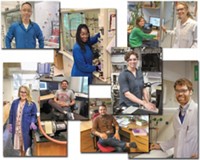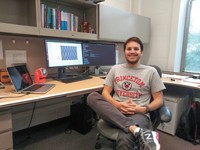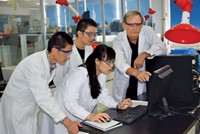Advertisement
Grab your lab coat. Let's get started
Welcome!
Welcome!
Create an account below to get 6 C&EN articles per month, receive newsletters and more - all free.
It seems this is your first time logging in online. Please enter the following information to continue.
As an ACS member you automatically get access to this site. All we need is few more details to create your reading experience.
Not you? Sign in with a different account.
Not you? Sign in with a different account.
ERROR 1
ERROR 1
ERROR 2
ERROR 2
ERROR 2
ERROR 2
ERROR 2
Password and Confirm password must match.
If you have an ACS member number, please enter it here so we can link this account to your membership. (optional)
ERROR 2
ACS values your privacy. By submitting your information, you are gaining access to C&EN and subscribing to our weekly newsletter. We use the information you provide to make your reading experience better, and we will never sell your data to third party members.
Careers
International Experience
Rise of world-class research hubs in Asia and the Middle East entices young faculty to move abroad
by Linda Wang
November 22, 2010
| A version of this story appeared in
Volume 88, Issue 47

Walking across campus during his first week as a newly hired assistant professor, Valentin Rodionov felt strangely at home. Palm trees lined every street, just as they did at the University of California, Berkeley, where Rodionov had recently completed a postdoc. He was also minutes away from a beautiful body of water that reminded him of San Francisco Bay. And everywhere he looked, construction was taking place on a new building.
The only indication that Rodionov was in Saudi Arabia was an occasional dust storm whipping by or a glimpse of someone dressed in Islamic clothing. Such is Rodionov’s new life at King Abdullah University of Science & Technology (KAUST), a graduate research university on the coast of the Red Sea, which opened in September 2009 thanks to a $10 billion endowment from the king of Saudi Arabia.
Western-style universities and research parks are becoming more common in Asia and the Middle East. These institutions are flush with cash and, through earnest head-hunting, have attracted prominent chemists from across the Western world with generous funding and state-of-the-art research facilities. In fact, expatriates make up a significant proportion of the workforce at these research hubs.
Renowned chemists such as Jean M. J. Fréchet of UC Berkeley and Jean-Marie Basset of École Supérieure de Chimie Physique Électronique de Lyon have joined the leadership ranks at KAUST. Likewise, the biomedical research institutes of Singapore’s Agency for Science, Technology & Research (ASTAR), located in the sprawling Biopolis and Fusionopolis research complexes, have attracted the likes of Sir David P. Lane of the University of Dundee, in Scotland, and K. C. Nicolaou of Scripps Research Institute (C&EN, Feb. 27, 2006, page 10).
But another group is quietly making its mark at these foreign research institutions. Young faculty members such as Rodionov, who joined KAUST last month as an assistant professor of chemical sciences, are taking advantage of the generous funding packages to launch their academic careers, carry out cutting-edge science, and collaborate with researchers from all over the world. This international experience, they hope, will make them even more competitive when they return home. And it’s an adventure they just can’t pass up.
Chemists at the start of their careers may be in the best position to spend a period of time abroad because, unlike their more established counterparts, they have yet to start a research group, and their young families may be more flexible about moving.
Some early-career chemists have surprised even themselves by passing up offers of tenure-track positions in the U.S. to go abroad. Born and raised in the Midwest, Alan Sellinger had never considered living and working in a foreign country, much less uprooting his entire family to do so. He earned a Ph.D. from the University of Michigan, completed a postdoc at Sandia National Laboratories, and then worked in industry for several years, first at Canon Research Center America in Palo Alto, Calif., and then at Opsys U.S. Corp. in Fremont, Calif.
In 2003, Sellinger decided to transition from industry to academia. He received an offer for a tenure-track faculty position at the University of Connecticut. “I was a day or two from accepting that position when I got an e-mail from Singapore,” Sellinger recalls. The message was from Albert F. Yee, former chair of the department of materials science and engineering at the University of Michigan, who had spent three years in Singapore directing one of the ASTAR institutes.
“He shot me this e-mail right at the eleventh hour and said, ‘Before you make any decisions, we have an opening here that I think would be good for you,’ ” Sellinger tells C&EN. During a subsequent visit to Singapore, Sellinger was so impressed by the state-of-the art research facilities and the family-friendly atmosphere there that he accepted the offer.

Both KAUST and Singapore’s ASTAR institutes illustrate Asia’s and the Middle East’s growing ability to entice young talent from the West. “KAUST was really attractive,” says Rodionov, who turned down a number of tenure-track faculty positions in the U.S. to take KAUST’s offer. “The amount of start-up funding that a young faculty member can get here is an order of magnitude better than what is available from a typical U.S. institution.” Rodionov also has access to state-of-the-art equipment, such as a 900-MHz nuclear magnetic resonance instrument. “We have excellent facilities that support our research in a standard seen nowhere else in the world,” says Jörg Eppinger, a chemist from Germany who joined KAUST as an assistant professor of chemical sciences in 2009.
These foreign institutions often provide generous subsidies to help smooth the transition for a young family. Canadian chemist Tyler B. Norsten says he struggled with his decision to move his wife and three young children to Singapore to take a position as a research scientist at ASTAR’s Institute of Materials Research & Engineering. Previously a staff scientist at Xerox Research Centre of Canada, Norsten saw the move to Singapore as a way to transition from industry to academia.
He worried, however, that such a big move would disrupt his children’s education. When he learned that there were excellent international schools in Singapore that his children could attend and that his expat package from ASTAR would cover most of the tuition, he and his wife were on board. “We saw this as our last opportunity to try something different,” Norsten says, adding that it would have been much harder to move if his children had been older and more established in their routines.
For many expats, working abroad is an eye-opening experience that can lead to unimaginable opportunities. Vivek Polshettiwar admits that before he joined KAUST in October 2009 as a senior research scientist, he had no idea what research was being done in the Middle East. Polshettiwar was nearing completion of a three-year fellowship at the U.S. Environmental Protection Agency in Cincinnati when he saw an opening at KAUST posted on the ACS Careers website. He began researching the university and discovered that many prominent chemists were there. Polshettiwar says one of the biggest motivations for him to move to Saudi Arabia was the opportunity to work with Basset, a leader in catalysis who directs the KAUST Catalysis Research Center. Their collaborative work has already resulted in a publication (Angew. Chem. Int. Ed., DOI: 10.1002/anie.201003451).
Having international experience can open up new opportunities for expats once they return home. After spending five years in Singapore, Sellinger returned to the U.S. in 2008 to accept a contract position as both a consulting associate professor in the department of materials science and engineering at Stanford University and the executive director of the Center for Advanced Molecular Photovoltaics, a $25 million global research collaboration between Stanford and KAUST. “Because of the international experience and the ability to publish our research findings in top scientific journals, the time I spent in Singapore certainly helped me get the job at Stanford,” Sellinger says.
Despite the attractiveness of working abroad, the number of young faculty from the U.S. who have joined KAUST and Singapore’s ASTAR institutes remains small compared with the number of young faculty from Europe and Asia who are working at these institutions. Sellinger suggests that Europeans and Asians may be more accustomed to the concept of working abroad. But he acknowledges that the U.S.’s struggling economy and the limited number of faculty positions may prompt more Americans to search overseas for work.
Sometimes the best preparation for going abroad is to keep an open mind and remain flexible. “I don’t think anybody ever knows what to expect until they arrive,” Norsten says. For example, it has taken him longer than he had anticipated to build his own research group because coming from industry, he had to learn how to write grant proposals and transition from working in the lab to project management. “There’s kind of a culture shock, so you’re trying to adjust,” he says. “I was pretty stressed out the first year, but now I’m starting to temper my expectations and just go with the flow, and things are coming along.” Norsten now has five people working under him on two separate projects, and he says that’s a size he’s comfortable with.
Another adjustment he’s had to make is in learning how to compete for additional research funding. Norsten says the ASTAR institutes put a heavy emphasis on collaborations, and research teams that work together are more likely to be awarded the bigger grants. “It really forces you to collaborate and get to know your colleagues,” he says. Norsten has spent the past 18 months developing his networking skills and is starting to collaborate on some projects, but he admits that the experience is still a bit “nerve-racking.”
Although research hubs such as KAUST and the ASTAR institutes have a Western feel, their juxtaposition with a foreign society can feel isolating. “When you’re at KAUST, you don’t feel like you’re in Saudi Arabia,” Eppinger says. “People feel immediately at home because it is so similar to what they know. But if you step outside of KAUST, it’s suddenly a really different world.” For example, Eppinger says, Saudis abide by strict prayer times throughout the day, and women are not allowed to drive.
Sellinger felt a similar isolation living in Singapore. “It’s such a tiny island,” he says. “Living there for five years, you just run out of things to do.” As a respite, he and his family took advantage of their proximity to other Southeast Asian countries and did a fair amount of traveling.
Of course, the move to Singapore or Saudi Arabia is unlikely to be permanent: Neither KAUST nor Singapore’s ASTAR institutes offer tenure. Rather, faculty and research scientists are hired on short-term contracts. At KAUST, for example, faculty members are hired on a five-year contract with an option to renew. “I think that fits very much the model of KAUST, having new people coming in with new ideas,” Eppinger says.
And it’s never too early to consider working abroad. In addition to looking for faculty members, many of these foreign research institutions are also seeking graduate students and postdocs. Rodionov, for example, is building his research group at KAUST and is seeking postdocs with a strong background in organic or colloidal chemistry. “I’m looking for adventurous souls to come and share in the adventure,” he says.





Join the conversation
Contact the reporter
Submit a Letter to the Editor for publication
Engage with us on Twitter